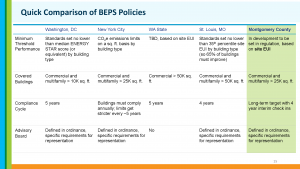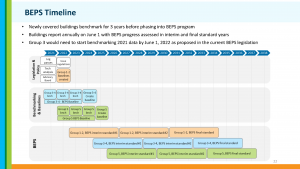On April 19, 2022, the Montgomery County Council unanimously passed its Building Energy Performance Standards (BEPS) legislation, which will help the County meet its climate goals.
Montgomery County is one of the first municipalities to pass BEPS legislation, and like its neighbor DC, the focus is on energy-efficiency improvements for existing buildings and expands on the benchmarking law. It includes County-owned, commercial, and multi-family buildings. This landmark piece of legislation will also help the county accelerate its climate goals to achieve carbon neutrality by 2035.
Benchmarking Law
One goal of the legislation is to expand the buildings covered by the Benchmarking Law. Under the current law, county-owned buildings and non-residential properties are covered if they are 50,000 gross square feet or more. However, amendments would phase in the newly covered buildings as outlined in the table below.
| Group 3 | |
| Additional County-Owned Buildings | 25,000-50,000 SF |
| Additional Non-Residential Properties | 25,000-50,000 SF |
| Group 4 | |
| Larger Multi-Family Properties | 250,000+ SF |
| Group 5 | |
| Smaller Multi-family Properties | 25,000-250,000 SF |
The proposed amendment to the Benchmarking Law would increase the covered buildings from 114M SF to approximately 220M SF and the commercial floor area coverage from 40% to 85%.
How Does Montgomery County’s legislation compare to others across the country?

Graphic courtesy of the Montgomery County Department of Environmental Protection
Unlike the BEPS program in Washington, D.C., Montgomery County’s legislation will regulate the minimum threshold performance based on site energy use intensity (EUI) rather than ENERGY STAR score. The coverage minimum has also been set at 25K SF for commercial and multi-family buildings, and properties will be evaluated every four years to determine whether they are meeting the interim targets defined in regulation. Comparatively, the District’s building coverage begins at 10K SF for commercial and multi-family buildings, which are assessed for compliance every five years.
BEPS Timeline and Compliance

Graphic courtesy of the Montgomery County Department of Environmental Protection
Initially, newly covered properties will benchmark for three years before phasing into the BEPS program. Once a property has phased in, it will report on interim targets every 4 years. If a property cannot meet interim or final performance standards, the county will accept a Building Performance Improvement Plan (BPIP). Owners completing actions in the BPIP timeline will be considered in compliance. If a property owner does not meet the BEPS target or have an approved BPIP, the building will be classified as non-compliant and subject to a Poor Performance Payment (PPP).
What’s Next?
There are still many remaining items and details to be determined in regulation, which will be communicated in real-time updates on the BEPS website.
For a general overview of the BEPS legislation, visit the Montgomery County Website.
In addition, the State of Maryland has passed the Climate Solutions Now Act of 2022, which includes provisions for a state-wide building energy performance standard for buildings greater than 35,000 square feet. The goals include net-zero direct greenhouse gas emissions by 2040 and an interim target of a 20% reduction in net direct GHG emissions by 2030 for existing buildings. Regulations must be adopted by June of 2023 and will include energy use intensity (EUI) targets.
When retrofitting projects in Montgomery County, building owners should consider the impacts of the state-level legislation, in addition to the local regulations. With the state’s focus on greenhouse gas emissions, buildings should consider electrification and energy efficiency, as well as factor in the cost of non-compliance with either program.
